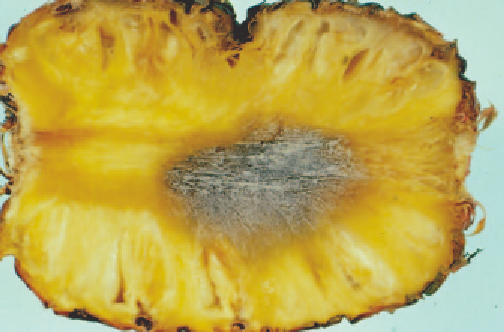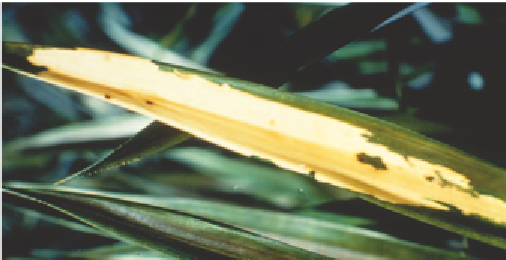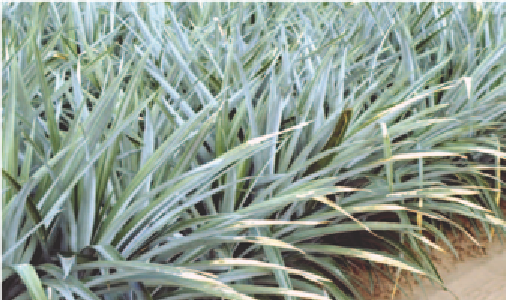Agriculture Reference
In-Depth Information
Dip the base of the fruit in a recommended fungicide
within fi ve hours of harvesting and store fruit at 9
•
C.
This is most important for fruit harvested during warm,
wet weather.
°
Remove pineapple refuse and rejected fruit from in and
around the packing shed. Treat the shed with the
recommended disinfectant once a week.
•
WHITE LEAF SPOT
■
Cause
The fungus
Chalara paradoxa
, which also causes water
blister and butt (base) rot.
Fig 16.22 Internal symptoms of water blister.
Symptoms
Symptoms include water blister, which is also referred to as
black rot or soft rot. This causes a soft, watery rot of the fruit
f flesh and makes the overlying skin glassy, water-soaked and
brittle. Eventually, the skin, f flesh and core disintegrate and
the fruit leaks through the shell. In advanced cases, this
leaves a fruit shell containing only a few black fibres. This
shell collapses under the slightest pressure.
Symptoms
The first symptom is a small, brown spot on the leaf, usually
where the leaf margin has been rubbed by another leaf
during strong winds. These spots lengthen rapidly during
wet weather. During prolonged wet periods, spots may
reach more than 20 cm in length and spread to the leaf tip.
Fine weather rapidly dries the affected area leaving cream-
coloured or almost white, papery spots; hence the name
'white leaf spot'. The margins of the spot often remain brown.
Source of infection and spread
The fungus is common in pineapple fields. Infection
occurs through shell bruises and growth cracks but mainly
through the broken fruit stalks. The disease is most active
in warm, wet weather and is most severe from January to
April, when the summer crop is harvested. The correlation
between rainfall before harvest and disease after harvest
has resulted in the name 'water blister'. When fresh fruit
are marketed with the crowns left on, this eliminates a
major point of entry for the fungus.
Importance
This is the major postharvest disease of fruit for the fresh-
fruit market. The disease takes three to four days to
develop after harvest and is therefore not a common
problem in fruit used for canning. Water blister can be
severe in fresh fruit consigned to distant markets when
refrigeration is not available. The disease does not occur
in the field unless fruit are over-ripe or injured.
Fig 16.23 White leaf spot on a pineapple leaf.
Management
•
Handle fruit carefully to avoid bruising and scuffi ng.
Rapid fungal invasion occurs through even minute,
weeping fractures.
Reject sunburnt and damaged fruit, because these often
have minor skin cracks that are readily infected.
•
Fig 16.24 White leaf spot symptoms appearing in a pineapple crop.














